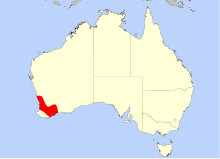The genus Drosera was divided in 1994 by Seine & Barthlott into three subgenera and 11 sections on the basis of morphological characteristics.

Drosera hartmeyerorum is a summer-growing annual sundew that is native to the north of Western Australia. It was discovered in 1995 by Siegfried and Irmgard Hartmeyer. Drosera hartmeyerorum has long scrambling leaves which readily curl around any unfortunate insect that lands on the leaves. One major thing that separates this sundew from others are the round yellow trichomes at the base of the leaves. The function of the yellow trichomes is uncertain. Like most sundews, it grows in warm wet, sandy, peaty areas with high humidity and low nutrient levels in the soil.

Drosera broomensis is a small, perennial carnivorous plant in the genus Drosera that is endemic to Western Australia. Its leaves are arranged in a small, leafy rosette, from which one to four inflorescences emerge. It produces white flowers in February and March. D. broomensis grows in sandy soils to the north and northeast of Broome in the Kimberley region. It was first described by Allen Lowrie in 1996, though earlier specimens from as early as 1891 had been collected. The specific epithet broomensis refers to the region in which it grows. It is closely related to Drosera petiolaris and differs from other related species by its glabrous inflorescence.

Drosera bulbosa, the red-leaved sundew, is a perennial tuberous species in the genus Drosera that is endemic to Western Australia. It grows in a rosette and produces white flowers emerge from April to June. D. bulbosa was first formally described by William Jackson Hooker in 1841.
Drosera fimbriata, the Manypeaks sundew, is a perennial tuberous species in the genus Drosera that is endemic to Western Australia. It grows to 10 to 15 cm tall with two or three whorls of non-carnivorous leaves on the lower portion of the stem and 2 to 5 whorls of carnivorous leaves above that. It is native to a region mostly around Manypeaks but with populations near the Scott River and near Denmark. It grows in winter-wet sandy soils in heathland. It flowers in October.
Drosera humilis is a perennial tuberous species in the genus Drosera that is endemic to Western Australia. It has 3 to 5 semi-erect stems that are 3 to 15 cm long with carnivorous leaves arranged in whorls around the stems. It is native to a region from the Moore River north to Kalbarri and east to Ajana and Wongan Hills. It grows in winter-wet sandy soils in heathland. It flowers from June to September.
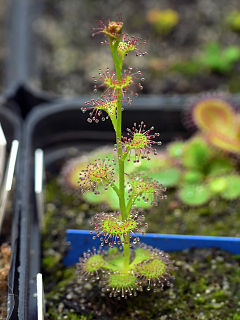
Drosera platypoda, the fan-leaved sundew, is a tuberous perennial species in the genus Drosera that is endemic to south-west Western Australia. It grows 15 to 20 cm tall with a basal rosette of leaves with alternate cauline leaves along the stem. It is native to a region from Manjimup south-west to an area around the Scott River and east to Cape Riche. It grows in winter-wet sandy soils in heathland. It flowers in October.
Drosera purpurascens is a compact tuberous perennial species in the genus Drosera that is endemic to south-west Western Australia. It produces 1 erect or 2 to 5 semi-erect lateral stems that grow to 3 to 10 cm long. The compact size of the plant combined with relatively long petioles distinguish it from all other members of the section Stolonifera. It is native to a region from Mount Cooke to near Katanning and Ongerup south to the Denmark-Albany region. It grows in sand-laterite soils and flowers from July to October, flowering en masse after bushfires.

Drosera ramellosa, sometimes referred to as the branched sundew, is a tuberous perennial species in the genus Drosera that is endemic to Western Australia. It was first formally described by Johann Georg Christian Lehmann in 1844. It was again described by Jules Émile Planchon as Drosera penduliflora in 1848, which was reduced to synonymy under D. ramellosa in 1864 by George Bentham.
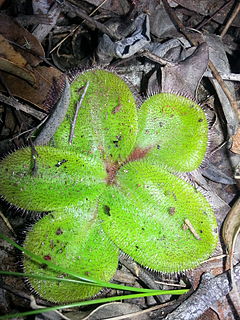
Drosera macrophylla, the showy sundew, is a perennial tuberous species in the genus Drosera that is endemic to Western Australia. It grows in a rosette with leaves 4 cm (2 in) long and 2 cm (1 in) wide. It is a common species east of Perth. It grows in loam soils. It flowers from June to October. D. macrophylla was first described by John Lindley in his 1839 publication A sketch of the vegetation of the Swan River Colony. In 1992, Allen Lowrie and Sherwin Carlquist described a new subspecies, D. macrophylla subsp. monantha, which is distinguished from D. macrophylla subsp. macrophylla by its single-flowered or rarely biflowered inflorescences. Subspecies monantha is abundant in the Bruce Rock/Merredin region.
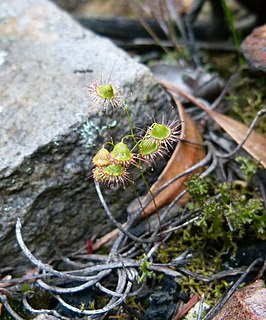
Drosera huegelii, the bold sundew, is an erect perennial tuberous species in the carnivorous plant genus Drosera that is endemic to Western Australia. It grows in sandy soils in winter-wet depressions and margins of swamps and occurs along the south-west coast of Australia. D. huegelii produces small, bell-shaped leaves along an erect stem that can be 10–50 cm (4–20 in) tall. White to cream-coloured flowers emerge from June to September.
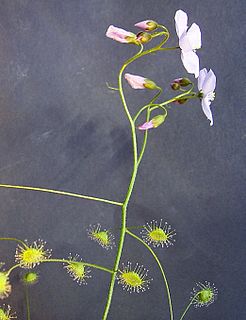
Drosera macrantha, the bridal rainbow, is a scrambling or climbing perennial tuberous species in the carnivorous plant genus Drosera that is endemic to Western Australia. It grows in a variety of habitats, including winter-wet depressions in sandy, loamy, laterite, or quartzite soils. D. macrantha produces small, cup-shaped carnivorous leaves along a long stem that can be 0.16–1.5 m (0.5–4.9 ft) high as it climbs. Its 1 in (2.5 cm) white or pink flowers emerge from June to November, blooming earlier in the more northern range.
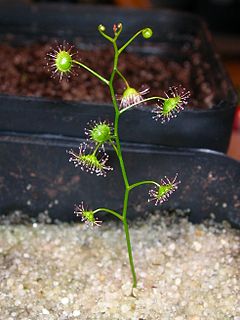
Drosera menziesii, the pink rainbow, is an erect or scrambling perennial tuberous species in the carnivorous plant genus Drosera. It is endemic to Western Australia and grows in a variety of habitats, including winter-wet depressions, swamps, and granite outcrops in clay or peat sand soils or loam. D. menziesii produces small, circular carnivorous leaves along an undulating erect stem that can be .05–1.1 m (0.2–3.6 ft) high. Its pink flowers emerge from July to November.
Drosera modesta, the modest rainbow, is a scrambling perennial tuberous species in the carnivorous plant genus Drosera. It is endemic to Western Australia and grows on granite outcrops or stream banks in laterite or sand-clay soils. D. modesta produces shield-shaped carnivorous leaves with longer than normal tentacles. The scrambling stems can be 0.3–0.8 m (1.0–2.6 ft) long. White flowers bloom from October to November.
Drosera sulphurea, the sulphur-flowered sundew, is a scrambling perennial tuberous species in the carnivorous plant genus Drosera. It is endemic to Western Australia and is found in coastal areas in sandy loam, often among Cephalotus. D. sulphurea produces small, shield-shaped carnivorous leaves along stems that can be 40–60 cm (16–24 in) high. Yellow flowers bloom in September.
Drosera zigzagia is an erect perennial tuberous species in the carnivorous plant genus Drosera. It is endemic to Western Australia and is found on the margins of salt lakes in brown sandy loam, often associated with D. salina, Stylidium insensitivum, S. pulviniforme, Levenhookia leptantha, and Frankenia species. Drosera zigzagia produces small, solitary carnivorous leaves that alternate along a zigzag stem, which can be 5–7 cm (2.0–2.8 in) high. Yellow flowers are borne on 4–9-flowered inflorescences that bloom from August to September.

Drosera glanduligera, the pimpernel sundew, is a rosetted annual species in the carnivorous plant genus Drosera that is endemic to Australia. It is 2.5–6 cm (1–2 in) tall and grows in most soil conditions. It produces orange flowers from August to November. It was originally described in 1844 by Johann Georg Christian Lehmann. It is the sole species in the subgenus Coelophylla, which Jan Schlauer elevated from section rank in 1996; it was originally described by Jules Émile Planchon in 1848.

Australia has one of the world's richest carnivorous plant floras, with around 187 recognised species from 6 genera.

Crepis barbigera is a North American species of flowering plant in the daisy family. It is native to the northwestern United States. It has been found in Washington, Oregon, and Idaho.

